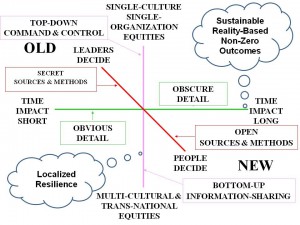
Huh?
The next corporate revolution will be power to the peons
‘Bureaucracy has to die,' says business consultant at CITE Conference (see video below)
Computerworld – SAN FRANCISCO — Microsoft, Hewlett-Packard, Dell and Intel have something in common: They all came late to the mobile revolution.
Why? Because they're companies where management is top-down and responsibility for innovation and change is concentrated among executives with strict bureaucratic control over workers.
That's got to change, Gary Hamel, a consultant and management educator at the London School of Business, said at the CITE Conference and Exhibition here this week. And he was not alone in his belief that the next revolution in corporate America won't be technological, it'll be social.
Businesses are on the cusp of a leadership revolution because millennials moving into the workforce are “the most authority-phobic” generation in history, Hamel said.
“Now, we have a generation with a completely different set of expectations — and probably the most core expectation they have is that if you're a leader, it's only because people are wiling to follow,” he said. “The real problem we're up against is not technology, it's that management DNA in companies…. When you concentrate the responsibility for innovation at the top, you're holding your capacity to change hostage. It disempowers the little people.”
Hamel pointed to the bring-your-own-device (BYOD) trend as the tip of a larger change coming, where employees can be more creative and have more decision-making power.
Not only should they be rewarded for being creative, they should be given the power to spend corporate money on research and development, he said. By doing that, companies will diversity their experimental capital.
“If you don't do that, you'll never change that innovation curve,” Hamel said. “BYOD is a great start, but I think it's the beginning of something more radical. Bureaucracy has to die. There's no way around it.”
While many companies already encourage employees to speak up when they see problems, they don't allow them to pick their own leaders and get rid of people who shouldn't be in leadership.
Kevin Jones, a consulting social & organizational strategist for NASA's Marshall and Goddard Space Flight Centers, agreed that traditional corporate culture needs a radical shakeup.
Jones, who spoke on a panel about gamification and the social enterprise, said that while companies tend to focus on how technology can pay off, business leaders should be pushing for a more innovative and collaborative workforce.
“The values of management today are different from the values of the social enterprise and different from the values of the consumerization of IT– and they're not mixing very well,” Jones said. “That's where we're having the battle.”
The default in organizations today is control from the top, when it should be control from the bottom up.
Tom Petrocelli, an independent industry analyst, how to best to use technology. Internal social networks, for example, allow lower-level employees to collaborate on innovation. But 40% of knowledge workers never even use them to collaborate because the networks were rolled out without a use case.
“No one went in and said, ‘This is the use case where this will help you get this task done.' There's no purpose to it,” Petrocelli said. “You need to start small and look for purposeful use cases.”
Click for Option to Watch Short Video on Why Bureaucracy is OUT

Phi Beta Iota: This is not new. What is new is that the meme is slowly penetrating the closed minds of corporate leaders. US Government leaders will of course be the last to get it. Some of us called for change in 1988-1994 — the collective intelligence meme started taking off roughly at the same time that the Internet went mainstream. Now is is established wisdom — everywhere EXCEPT within the top-down hierarchies, that bottom up with total diversity (“radical inclusiveness”) is the only way to get it right. Here is one of the graphics from the mid-1990's that explains the difference between the still prevalent top down “command and control” model, and the much more robust and agile “bottom up” model — the alternative C2 model.
See Also:
1992 E3i: Ethics, Ecology, Evolution, & intelligence
2006 Forbes Blank Slate On Intelligence
2008 Chapter: Paradigms of Failure
2012 PREPRINT: The Craft of Intelligence [Full Text Online]
2013 INTERVIEW: Open Everything – with Robert David STEELE Vivas UPDATED to Add Parts V and VI
2013 Robert Steele in HighGainBlog on Open and Secret Intelligence



